Le cube

Voici son code:
u:=1cm; figure (-8u,-8u,10u,8u); pair A,B,C,D,E,F,G,H; pair V; numeric c; c:=4; %côté du cube A=(0,0); B=(c*u,0); C=(c*u,c*u); D=(0,c*u); V=(2u,u); % vecteur pour la perspective E= A shifted V; F= B shifted V; G= C shifted V; H= D shifted V; draw A--B--C--D--cycle; draw B--F--G--C; draw G--H--D; draw A--E--F dashed evenly; draw H--E dashed evenly; label.llft(btex $A$ etex,A); label.lrt(btex $B$ etex,B); label.lrt(btex $C$ etex,C); label.ulft(btex $D$ etex,D); label.lrt(btex $E$ etex,E); label.rt(btex $F$ etex,F); label.top(btex $G$ etex,G); label.top(btex $H$ etex,H); fin;
Le pavé droit

Voici son code:
u:=1cm; figure (-8u,-8u,10u,8u); pair A,B,C,D,E,F,G,H; pair V; numeric AB,AD; AB:=6; %dimensions de la face avant AD:=3; A=(0,0); B=(AB*u,0); C=(AB*u,AD*u); D=(0,AD*u); V=(2u,u); % vecteur pour la perspective E= A shifted V; F= B shifted V; G= C shifted V; H= D shifted V; draw A--B--C--D--cycle; draw B--F--G--C; draw G--H--D; draw A--E--F dashed evenly; draw H--E dashed evenly; label.llft(btex $A$ etex,A); label.lrt(btex $B$ etex,B); label.lrt(btex $C$ etex,C); label.ulft(btex $D$ etex,D); label.lrt(btex $E$ etex,E); label.rt(btex $F$ etex,F); label.top(btex $G$ etex,G); label.top(btex $H$ etex,H); trace cotation(A,B,-5mm,2mm,btex $L$ etex); trace cotation(A,D,5mm,2mm,btex $h$ etex rotated -90); trace cotation(B,F,-5mm,2mm,btex $l$ etex); fin;
Le tétraèdre

u:=1cm; figure (-8u,-8u,10u,8u); pair S,A,B,C; A=(0,0); B=(3u,-u); C=(4u,u); S=(1.5u,5u); draw S--A; draw S--B; draw S--C; draw A--C dashed evenly; draw A--B--C; nomme.lft(A); nomme.bot(B); nomme.rt(C); nomme.top(S); fin;
La pyramide
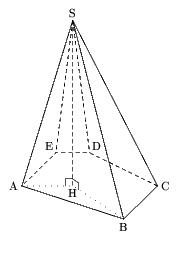
Voici son code:
u:=1cm; figure (-8u,-8u,10u,8u); pair S,A,B,C,D,E,H; A=(0,0); B=(3u,-u); C=(4u,0); D=(2u,u); E=(u,u); H=(1.5u,0); S=(1.5u,5u); draw S--A; draw S--B; draw S--C; draw S--D dashed evenly; draw S--E dashed evenly; draw A--B--C; draw C--D--E--A dashed evenly; draw S--H dashed evenly; draw H--A dashed withdots; draw H--B dashed withdots; trace codeperp(S,H,A,6); trace codeperp(S,H,B,6); nomme.lft(A); nomme.bot(B); nomme.rt(C); nomme.urt(D); nomme.ulft(E); nomme.top(S); nomme.bot(H); fin;
La pyramide régulière à base carrée
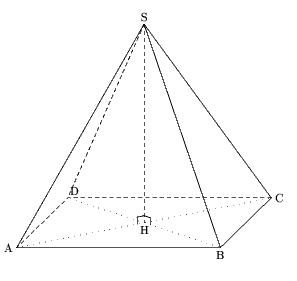
Voici son code:
u:=1cm; figure (-8u,-8u,10u,8u); pair S,A,B,C,D,H; pair V; numeric h; h:=6; %hauteur A=(0,0); B=(6u,0); V=(1.5u,1.5u); C=B shifted V; D=A shifted V; H=0.5[A,C]; S=H shifted (0,h*u); draw S--A; draw S--B; draw S--C; draw S--D dashed evenly; draw A--B--C; draw C--D--A dashed evenly; draw S--H dashed evenly; draw C--A dashed withdots; draw D--B dashed withdots; trace codeperp(S,H,A,6); trace codeperp(S,H,B,6); nomme.lft(A); nomme.bot(B); nomme.rt(C); nomme.urt(D); nomme.top(S); nomme.bot(H); fin;
la pyramide régulière à base carrée et sa réduction

Voici son code:
u:=1cm; figure (-8u,-8u,10u,12u); pair S,A,B,C,D,H; pair V; numeric h; h:=6; %hauteur A=(0,0); B=(6u,0); V=(1.5u,1.5u); C=B shifted V; D=A shifted V; H=0.5[A,C]; S=H shifted (0,h*u); draw S--A; draw S--B; draw S--C; draw S--D dashed evenly; draw A--B--C; draw C--D--A dashed evenly; draw S--H dashed evenly; draw C--A dashed withdots; draw D--B dashed withdots; trace codeperp(S,H,A,6); trace codeperp(S,H,B,6); label.lft(btex $A$ etex,A); label.bot(btex $B$ etex,B); label.rt(btex $C$ etex,C); label.urt(btex $D$ etex,D); label.top(btex $S$ etex,S); label.bot(btex $H$ etex,H); pair AA,BB,CC,DD,HH; numeric cr; cr:=0.4; %coefficient de réduction AA:=cr[S,A]; BB:=cr[S,B]; CC:=cr[S,C]; DD:=cr[S,D]; HH:=cr[S,H]; draw AA--BB--CC;
Le cône de révolution
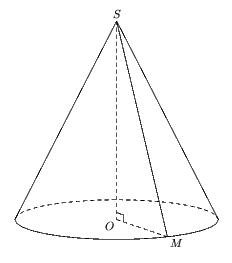
Voici son code:
u:=1cm; figure (-8u,-8u,10u,8u); pair A,B,O,S,M; numeric rb,h; rb:=3; % rayon de base h:=6; % hauteur A=(-rb*u,0); O=(0,0); B=(rb*u,0); S=(0,h*u); path cc; cc= cercles(O,rb*u); cc := cc yscaled 0.2; draw subpath (0, length cc /2) of cc dashed evenly; draw subpath (length cc /2,length cc) of cc; draw A--S--B; draw S--O dashed evenly; numeric ang; ang:=300; % angle servant à placer M M:=point (length cc *ang/360) of cc; draw O--M dashed evenly; draw S--M; trace codeperp(S,O,M,6); label.top(btex $S$ etex,S); label.llft(btex $O$ etex,O); label.lrt(btex $M$ etex,M); fin;
Le cône de révolution et sa réduction
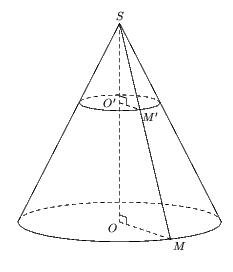
Voici son code:
u:=1cm; figure (-8u,-8u,10u,8u); pair A,B,O,S,M; numeric rb,h; rb:=3; % rayon de base h:=6; % hauteur A=(-rb*u,0); O=(0,0); B=(rb*u,0); S=(0,h*u); path cc; cc= cercles(O,rb*u); cc := cc yscaled 0.2; draw subpath (0, length cc /2) of cc dashed evenly; draw subpath (length cc /2,length cc) of cc; draw A--S--B; draw S--O dashed evenly; numeric ang; ang:=300; % angle servant à placer M M:=point (length cc *ang/360) of cc; draw O--M dashed evenly; draw S--M; trace codeperp(S,O,M,6); label.top(btex $S$ etex,S); label.llft(btex $O$ etex,O); label.lrt(btex $M$ etex,M); pair OO,MM; numeric cr; cr:=0.4; cc:= cercles(O,cr*rb*u); cc:= cc yscaled 0.2; cc:=cc shifted cr[S,O]; draw subpath (0, length cc /2) of cc dashed evenly; draw subpath (length cc /2,length cc) of cc; MM:=cr[S,M]; OO:=cr[S,O]; label.lft(btex $O'$ etex,OO); label.lrt(btex $M'$ etex,MM); draw OO--MM dashed evenly; trace codeperp(S,OO,MM,6);
La boule ou la sphère

Voici son code:
u:=1cm; figure (-8u,-8u,10u,8u); pair A,B,O,S,M; numeric rb; rb:=3; % rayon A=(-rb*u,0); O=(0,0); B=(rb*u,0); path cc; cc= cercles(O,rb*u); draw cc; cc := cc yscaled 0.2; draw subpath (0, length cc /2) of cc dashed evenly; draw subpath (length cc /2,length cc) of cc; numeric ang; ang :=300; % angle fixant M M=point (length cc *ang/360) of cc; draw O--M; nomme.lft(O); nomme.lrt(M); label.urt(btex $R$ etex,0.5[O,M]); marque_p := "croix"; MarquePoint(O); marque_p := "rien"; fin;
Section par un plan de la boule ou de la sphère
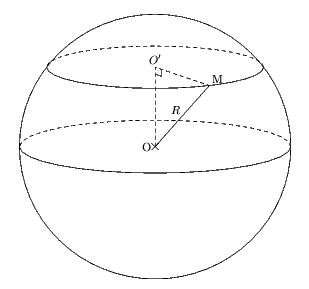
Voici son code:
u:=1cm; figure (-8u,-8u,10u,8u); pair A,B,O,S,M,OO; numeric rb; rb:=4; %rayon de la boule A=(-rb*u,0); O=(0,0); B=(rb*u,0); numeric cr,rr; cr:=0.6; %coefficient servant à placer O' rr:=rb*sqrt(1-cr*cr); OO=(0,cr*rb*u); path cc; cc= cercles(O,rb*u); draw cc; cc := cc yscaled 0.2; draw subpath (0, length cc /2) of cc dashed evenly; draw subpath (length cc /2,length cc) of cc; cc := cercles(O,rr*u); cc := cc yscaled 0.2; cc := cc shifted (0,cr*rb*u); draw subpath (0, length cc /2) of cc dashed evenly; draw subpath (length cc /2,length cc) of cc; numeric ang; ang :=300; % angle fixant M M=point (length cc *ang/360) of cc; nomme.lft(O); nomme.urt(M); draw O--M; draw O--OO--M dashed evenly; trace codeperp(O,OO,M,6); label.top(btex $O'$ etex, OO); label.ulft(btex $R$ etex, 0.5[O,M]); marque_p := "croix"; MarquePoint(O); marque_p := "rien";
Cylindre couché
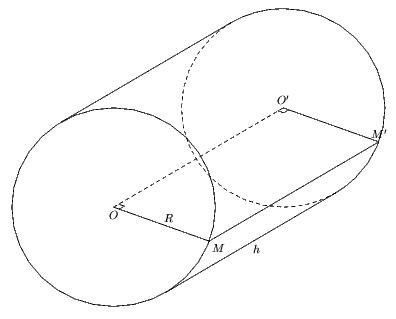
Voici son code:
u:=1cm; figure (-8u,-8u,10u,8u); pair A,B,O,AA,BB,OO,M,MM,I; numeric rb; rb:=3; % rayon de base pair V; V:=(5u,3u); % vecteur O=(0,0); OO:= O shifted V; path cc; cc= cercles(O,rb*u); draw cc; path d; d:=demidroite(O,OO); I := d intersectionpoint cc; A:= rotation(I,O,270); AA:= A shifted V; B= symetrie(A,O); BB:= B shifted V; trace arccercle(BB,AA,OO) dashed evenly; trace arccercle(AA,BB,OO); draw A--AA; draw B--BB; draw O--OO dashed evenly; numeric ang; ang:=340; % angle servant à placer M M:=point (length cc *ang/360) of cc; draw O--M; trace codeperp(M,O,OO,5); MM:= M shifted V; draw OO--MM; draw M--MM; trace codeperp(O,OO,MM,5); label.b
Cylindre debout

Voici son code :
u:=1cm; figure (-8u,-8u,10u,8u); pair A,B,O,AA,BB,OO,M,MM; numeric rb,h; rb:=3; % rayon de base h:=6; % hauteur O=(0,0); OO:= O shifted (0,h*u); A=(-rb*u,0); AA:= A shifted (0,h*u); B=(rb*u,0); BB:= B shifted (0,h*u); path cc; cc= cercles(O,rb*u); cc := cc yscaled 0.2; draw subpath (0, length cc /2) of cc dashed evenly; draw subpath (length cc /2,length cc) of cc; draw cc shifted (0,h*u); draw A--AA; draw B--BB; draw O--OO dashed evenly; numeric ang; ang:=300; % angle servant à placer M M:=point (length cc *ang/360) of cc; draw O--M dashed evenly; trace codeperp(M,O,OO,5); MM:= M shifted(0,h*u); draw OO--MM; draw M--MM; trace codeperp(O,OO,MM,5); label.bot(btex $O$ etex,O); label.top(btex $O'$ etex,OO); label.lrt(btex $M$ etex,M); label.top(btex $M'$ etex,MM); label.urt(btex $R$ etex,0.5[O,M]); label.rt(btex $h$ etex,0.5[B,BB]); fin;